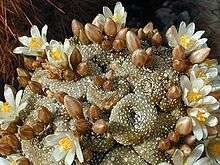Blossfeldia
| Blossfeldia | |
|---|---|
 | |
| Scientific classification | |
| Kingdom: | Plantae |
| Clade: | Angiosperms |
| Clade: | Eudicots |
| Order: | Caryophyllales |
| Family: | Cactaceae |
| Subfamily: | Cactoideae |
| Genus: | Blossfeldia |
| Species: | B. liliputana |
| Binomial name | |
| Blossfeldia liliputana Werderm.[1] | |
| Synonyms[1] | |
| |
Blossfeldia is a genus of cactus (family Cactaceae) containing only one species, Blossfeldia liliputana,[1] native to South America in northwestern Argentina[2] (Jujuy, Salta, Tucumán and Catamarca Provinces) and southern Bolivia[2] (Potosí Department). It grows at 1,200–3,500 m altitude in the Andes, typically growing in rock crevices,[2] and often close to waterfalls.
It is of note as the smallest cactus species in the world, with a mature size of around 10–12 mm diameter. The flowers are white or rarely pink, 6–15 mm long and 5–7 mm diameter.[2]
The species is named after the fictional country Lilliput where all the inhabitants are minute.
Taxonomy
The genus and species were first described in 1937 by Erich Werdermann after being discovered in northern Argentina by Harry Blossfeld and Oreste Marsoner. The genus name honours Blossfeld.[2] Blossfeldia liliputana has several features making it unique among cacti, including a very small number of stomata, the absence of a thickened cuticle, and hairy seeds with an aril. It is placed in the subfamily Cactoideae, and traditionally in the tribe Notocacteae.[2] However, molecular phylogenetic studies have repeatedly shown that it is sister to the remaining members of the subfamily, and well removed from other genera placed in the Notocacteae:[3][4]
| subfamily Cactoideae |
| ||||||||||||
Recognizing the position of Blossfeldia, Nyffler and Eggli in their 2010 classification of Cactaceae placed it in a separate tribe, Blossfeldieae, within Cactoideae.[5] Earlier, Blossfeldia had been placed in an entirely separate subfamily, Blossfeldioideae.[6]
References
- 1 2 3 "Blossfeldia liliputana Werderm.". The Plant List. Retrieved 2017-04-01.
- 1 2 3 4 5 6 Anderson, Edward F. (2001). The Cactus Family. Pentland, Oregon: Timber Press. pp. 129–130. ISBN 978-0-88192-498-5.
- ↑ Bárcenas, Rolando T; Yesson, Chris & Hawkins, Julie A (2011). "Molecular systematics of the Cactaceae". Cladistics. 27 (5): 470–489. doi:10.1111/j.1096-0031.2011.00350.x.
- ↑ Hernández-Hernández, Tania; Hernández, Héctor M.; De-Nova, J. Arturo; Puente, Raul; Eguiarte, Luis E. & Magallón, Susana (2011). "Phylogenetic relationships and evolution of growth form in Cactaceae (Caryophyllales, Eudicotyledoneae)". American Journal of Botany. 98 (1): 44–61. PMID 21613084. doi:10.3732/ajb.1000129.
- ↑ Nyffeler, R. & Eggli, U. (2010). "A farewell to dated ideas and concepts: molecular phylogenetics and a revised suprageneric classification of the family Cactaceae". Schumannia. 6: 109–149. doi:10.5167/uzh-43285.
- ↑ Crozier, B.S. (2004). "Subfamilies of Cactaceae Juss., including Blossfeldioideae subfam. nov.". Phytologia. 86: 52–64. Retrieved 2017-04-01.
Bibliography
- Buxbaum F., "Gattung Blossfeldia", in Krainz H., Die Kakteen, 1.11.1964
- Fechser H., "Blossfeldia liliputana - The Tiniest Cactus", Cact. Succ. J. (US), 32 : 123-125, 1960
- John V., "Strombocactus, Blossfeldia a Aztekium", Kaktusy, 23 : 38-41, 1987
- Kilian G., "Beitrag zur Blossfeldia-Kultur", Kakt. und and. Succ., 13 : 82-83, 1962
- Köhler U., "Beobachtungen an Blossfeldien", Kakt. und and. Succ., 17 : 11-14, 1966;
- "Blossfeldia heute", Kakt. und and. Sukk., 32 : 132133, 1981
- Říha J., "Blossfeldia liliputana Werdermann, Kaktusy, 22 : 105-107, 1986
- E. Werdermann (1937). "Neue und kritische Kakteen aus den Sammelergebnissen der Reisen von Harry Bloßfeld und O. Marsoner durch Südamerika 1936/37, III" (PDF). Kakteenkunde: 161–164. Retrieved 30 July 2014.
- Germplasm Resources Information Network: Blossfeldia liliputana
External links
- Mauseth cacti research: Blossfeldia liliputana
- Cacti Guide: Blossfeldia liliputana
- Blossfeldia liliputana habitat pictures